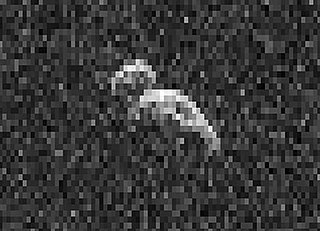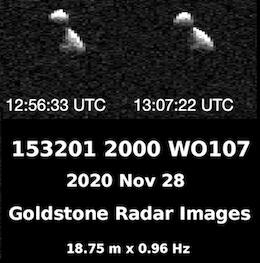
4769 Castalia is a near-Earth object and potentially hazardous asteroid of the Apollo group, approximately 1.4 kilometers in diameter and was the first asteroid to be modeled by radar imaging. It was discovered on 9 August 1989, by American astronomer Eleanor Helin (Caltech) on photographic plates taken at Palomar Observatory in California. It is named after Castalia, a nymph in Greek mythology. It is also a Mars- and Venus-crosser asteroid.

66391 Moshup, provisional designation 1999 KW4, is a binary asteroid, classified as a near-Earth object and potentially hazardous asteroid of the Aten group, approximately 1.3 kilometers in diameter. It was discovered on 20 May 1999, by Lincoln Near-Earth Asteroid Research (LINEAR) at the Lincoln Laboratory's Experimental Test Site in Socorro, New Mexico, United States. It is a Mercury-crosser that comes extremely close to the Sun at a perihelion of 0.2 AU.
4450 Pan is a highly eccentric asteroid and contact binary, classified as a potentially hazardous asteroid and near-Earth object of the Apollo group, approximately 1.1 kilometers in diameter. It was discovered on 25 September 1987, by American astronomers Eugene and Carolyn Shoemaker at Palomar Observatory in California, United States. It was named after Pan from Greek mythology.

(136617) 1994 CC is a sub-kilometer trinary asteroid, classified as near-Earth object and potentially hazardous asteroid of the Apollo group.

(276033) 2002 AJ129, provisional designation 2002 AJ129, is a Mercury-crossing asteroid. It has the ninth-smallest perihelion of all numbered asteroids, after asteroids such as 2000 BD19, 2004 UL, and 2008 XM. It makes close approaches to all of the inner planets and asteroid 4 Vesta. The asteroid is estimated to be between 0.5–1.2 kilometers (0.3–0.7 mi) across. In January 2018 there was much media hype about this asteroid being classified as a potentially hazardous asteroid, although there is no known threat of an impact for hundreds if not thousands of years. The media has compared the size of the asteroid to the Burj Khalifa in Dubai.
(242450) 2004 QY2 (prov. designation:2004 QY2) is an asteroid on an eccentric orbit, classified as near-Earth object and potentially hazardous asteroid of the Apollo group, approximately 3 kilometers (2 miles) in diameter. It was discovered on 20 August 2004 by the Siding Spring Survey at an apparent magnitude of 16.5 using the 0.5-metre (20 in) Uppsala Southern Schmidt Telescope. It is one of the largest potentially hazardous asteroids known to exist.

(308242) 2005 GO21 is a large Aten near-Earth asteroid and potentially hazardous object. It has a well determined orbit with an observation arc of 7 years and an uncertainty parameter of 0. It was discovered on 1 April 2005 by the Siding Spring Survey at an apparent magnitude of 18.1 using the 0.5-metre (20 in) Uppsala Southern Schmidt Telescope.

(285263) 1998 QE2, provisional designation 1998 QE2, is a dark asteroid and synchronous binary system, classified as near-Earth object and potentially hazardous asteroid of the Amor group, approximately 3 kilometers in diameter. It was discovered on 19 August 1998, by astronomers of the LINEAR program at Lincoln Laboratory's Experimental Test Site near Socorro, New Mexico, in the United States. Its sub-kilometer minor-planet moon was discovered by radar on 30 May 2013.
(523662) 2012 MU2, provisional designation 2012 MU2, is a sub-kilometer asteroid on an eccentric orbit, classified as near-Earth object and potentially hazardous asteroid of the Apollo group. It was discovered on 18 June 2012 by astronomers of the Catalina Sky Survey at an apparent magnitude of 19.9 using a 0.68-meter (27 in) Schmidt–Cassegrain telescope. It has an estimated diameter of 240 meters (790 ft). The asteroid was listed on Sentry Risk Table with a Torino Scale rating of 1 on 23 June 2012.

(192642) 1999 RD32, provisional designation: 1999 RD32, is an asteroid and suspected contact binary on an eccentric orbit, classified as a large near-Earth object and potentially hazardous asteroid of the Apollo group, approximately 5 kilometers (3 miles) in diameter. It was discovered on 8 September 1999, at a magnitude of 18, by astronomers of the LINEAR program using its 1-meter telescope at the Lincoln Laboratory's Experimental Test Site near Socorro, New Mexico, United States. The asteroid is likely of carbonaceous composition and has a rotation period of 17.08 hours.

(388188) 2006 DP14, provisional designation 2006 DP14, is a sub-kilometer sized, peanut-shaped asteroid on a highly eccentric orbit, classified as near-Earth object and potentially hazardous asteroid of the Apollo group. This contact binary was discovered on 23 February 2006, by astronomers of the LINEAR program at the Lincoln Laboratory's Experimental Test Site near Socorro, New Mexico, in the United States. On 10 February 2014, it passed 6.25 lunar distances from Earth. The asteroid is approximately 400 meters in diameter and has a rotation period of 5.77 hours.

2014 HQ124 is a sub-kilometer asteroid, classified as near-Earth object and potentially hazardous asteroid of the Aten group, approximately 400 meters (1,300 feet) in diameter. It passed 3.25 lunar distances (LD) from Earth on 8 June 2014. It was discovered on 23 April 2014 by NEOWISE. It is estimated that an impact event would have had the energy equivalent of 2,000 megatons of TNT and would have created a 5 km (3 mi) impact crater. The news media misleadingly nicknamed it The Beast. 2014 HQ124 previously passed this close to Earth in 1952 and will not again until at least 2307. Radar imaging suggests it may be a contact binary.
2014 XL7 is a near-Earth object and Apollo asteroid, approximately 230 meters (750 feet) in diameter. It was the most dangerous potentially hazardous asteroid on Sentry Risk Table upon its discovery by the Mount Lemmon Survey in December 2014. At the time, the asteroid had a cumulative 1 in 83000 chance of impacting Earth on 4–5 June between the years 2048 and 2084. After the object's observation arc had been extended to 35 days, it was removed from the Sentry Risk Table on 15 January 2015. Since then the asteroid's orbit has been secured. Although it has an Earth minimum orbit intersection distance of less than one lunar distance, there are no projected close encounters with Earth in the foreseeable future, with its closest passage to occur in May 2046, still millions of kilometers away.
(523775) 2014 YB35, provisional designation 2014 YB35, is a stony near-Earth object and potentially hazardous asteroid of the Apollo group, approximately 300 meters (980 feet) in diameter. It was discovered on 27 December 2014 by the Catalina Sky Survey at the Catalina Station in Arizona, United States. In March 2015, a minor-planet moon, less than half the size of its primary, was discovered by radar astronomers at Goldstone Observatory. The primary body of the binary system has a rotation period of 3.3 hours, while the secondary's orbital period remains unknown.

(153201) 2000 WO107 is a sub-kilometer asteroid, classified as near-Earth object and potentially hazardous asteroid of the Aten group with a very well determined orbit. It was discovered on 29 November 2000, by astronomers of the Lincoln Near-Earth Asteroid Research (LINEAR) at the Lincoln Laboratory's Experimental Test Site near Socorro, New Mexico, in the United States. It is a contact binary.

(671294) 2014 JO25 is a near-Earth asteroid. It was discovered in May 2014 by astronomers at the Catalina Sky Survey near Tucson, Arizona - a project of NASA's NEO (Near Earth Object) Observations Program in collaboration with the University of Arizona.

(505657) 2014 SR339, provisional designation 2014 SR339, is a dark and elongated asteroid, classified as near-Earth object and potentially hazardous asteroid of the Apollo group, approximately 970 meters (3,200 feet) in diameter. It was discovered on 30 September 2014, by NASA's Wide-field Infrared Survey Explorer telescope (WISE) in Earth's orbit. Closely observed at Goldstone and Arecibo in February 2018, it has a rotation period of 8.7 hours.

(164121) 2003 YT1, provisional designation 2003 YT1, is a bright asteroid and synchronous binary system on a highly eccentric orbit, classified as near-Earth object and potentially hazardous asteroid of the Apollo group, approximately 2 kilometers (1.2 miles) in diameter. It was discovered on 18 December 2003, by astronomers with the Catalina Sky Survey at the Catalina Station near Tucson, Arizona, in the United States. The V-type asteroid has a short rotation period of 2.3 hours. Its 210-meter sized minor-planet moon was discovered at Arecibo Observatory in May 2004.

2016 AZ8 is a sub-kilometer asteroid and near-Earth object of the Apollo group, at least 400 meters (1,300 feet) in diameter. It was first observed on 3 January 2016, by the WISE telescope with precovery images found back in 2012.

(85990) 1999 JV6 (provisional designation 1999 JV6) is a sub-kilometer near-Earth asteroid and a potentially hazardous object of the Apollo group. It was discovered by astronomers of the LINEAR program at the Lincoln Laboratory's Experimental Test Site near Socorro, New Mexico. 1999 JV6 is a contact binary object consisting of two distinct lobes, as seen in radar images from various observatories including Arecibo and Goldstone in January 2015.



















